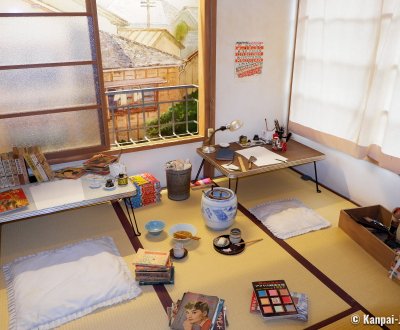Tokiwaso Manga Museum
Hot Spot for Great Contemporary Manga Artists
Tokiwaso Manga Museum is a former manga artists villa, rebuilt in 2020 and located in the Minami-Nagasaki (formerly Shiinamachi) district, in the west of Ikebukuro in Tokyo’s Toshima ward. A pilgrimage for otaku fans, this modest residential building sheltered the debuts of great contemporary Japanese mangakas in the 1950s.
In the north-west of Tokyo, Ikebukuro is one of the capital’s dynamic districts, with numerous shops and urban entertainment based on sports and popular Japanese culture (manga, anime and cosplay on the weekends). At a short distance, only 1 train 🚅 stop away, lies the Minami-Nagasaki district, also known as Shiinamachi, its former named still in use for its train station. Amateurs are aware of this very quiet and not touristic suburb as it is the historical living place of some of the most famous contemporary mangaka, such as Osamu Tezuka (1928 – 1989), considered the father of modern manga.
In the post-war period, Japan is recovering and the most promising manga artists settled in the capital, to work for magazines publishing their work every week. The magazine Manga Shonen (漫画少年), published by Gakudosha, a publishing house specializing in manga for boys, lodged its young authors in the Tokiwa Villa, in Toshima ward, only a few yards away from the center of Tokyo.
At the times, the aspiring manga artists’ boarding house was located in a highly cultural and creative neighborhood and was a typical construction of the Showa Era (1926 – 1989), a 2 levels-building with very minimal amenities. There were indeed no air-conditioning system for temperature control, nor bathroom 🛁, and the kitchen and the toilets 🚽 were communal. For showering, residents had to go to the sento public baths, that could easily be found at any street corner or near the stations.

The living place of Osamu Tezuka in his manga debuts
In 1953, Tokiwaso boarding house welcomed its 1rst tenant, who was Osamu Tezuka. He stayed about 1 year in the room 14, a 7,5 m² (4 tatamis and a half) space. Several Japanese manga household names would also live at Tokiwaso in the early days of their careers, such as:
- Hiro Terada (1931 - 1992), considered the legendary and benevolent head of the villa;
- Fujiko Fujio, the mangaka duo associating Hiroshi Fujimoto (1933 - 1996) alias Fujiko F. Fujio and Moto Abiko (1934 - 2022) alias Fujiko Fujio A, creators among other things of Obake no Q-taro and Doraemon;
- Shotaro Ishinomori (1938 - 1998);
- Fujio Akatsuka (1935 - 2008);
- Shin'ichi Suzuki (1933 - ), one of the founders of Studio Zero and director emeritus of the Suginami Animation Museum;
- Naoya Moriyasu (1934 - 1999);
- Tokuo Yokota (1936 - 2022);
- Hideko Mizuno (1939 - ); and,
- Joji Yamauchi (1940 - ), the last long-term resident and assistant to Fujio Akatsuka and Shotaro Ishinomori.
From a communal working and living space, the residence became a remarkable training school where residents encouraged each others, improved their skills and stimulated the creativity of each others. Tokiwaso was then a true incubator for successful mangaka for about 10 years, until its golden age in 1961. The iconic residents, who became successful authors, spread their wings and moved out.

Tokiwa-so villa’s revival in 2020
In 1982, the original building is destroyed due to its dilapidated state. Years later, the neighborhood, that had preserved the traces of the mangakas’ presence, completes a very ambitious project: giving a manga museum to Tokyo. The accurate reconstruction of the Tokiwa-so villa opens in the summer of 2020 and provides visitors with an immersion into a past time and into the daily life of manga artists before success.
Contrary to Kyoto International Manga Museum, that is rather a large library, Tokiwaso Museum focuses on the artists and the birth of the modern post-war manga movement, that is now very popular in the country and in the world.
Visitors take off their shoes and step into the house, touring the rooms that have been replicated up to their tiniest details and in such a vivid manner that one would not be surprised to meet one of the boarders in their room. The ground floor is laid out with both a permanent and a temporary exhibition space, displaying black and white pictures of Tokiwaso’s historical residents.

Tokyo’s manga artists historical neighborhood
In addition to visiting the museum-house, we recommend exploring the area of Minami-Nagasaki where a complementary course follows the steps of the mangaka. You can make interesting stops at:
- Tokiwaso Park where the boarding house was reconstructed, a replica of the Eden, a cafe where editors and authors could meet comfortably, as well as a monument named the "Tokiwaso heroes" with 10 authors’ caricatures and autographs;
- Tokiwaso Street Rest Place, used as a souvenir shop, which displays since 2013 a realistic painting of Hiroo Terada’s room; and,
- Tokiwaso Street Showa Retro Museum, inaugurated in 2023 and showing what life was like during the Showa era.
Thanks to this dive into the history of manga culture in Japan, you’ll also discover a human-sized and slightly retro residential neighborhood; a soothing interlude in Tokyo’s hustling and bubbling.

